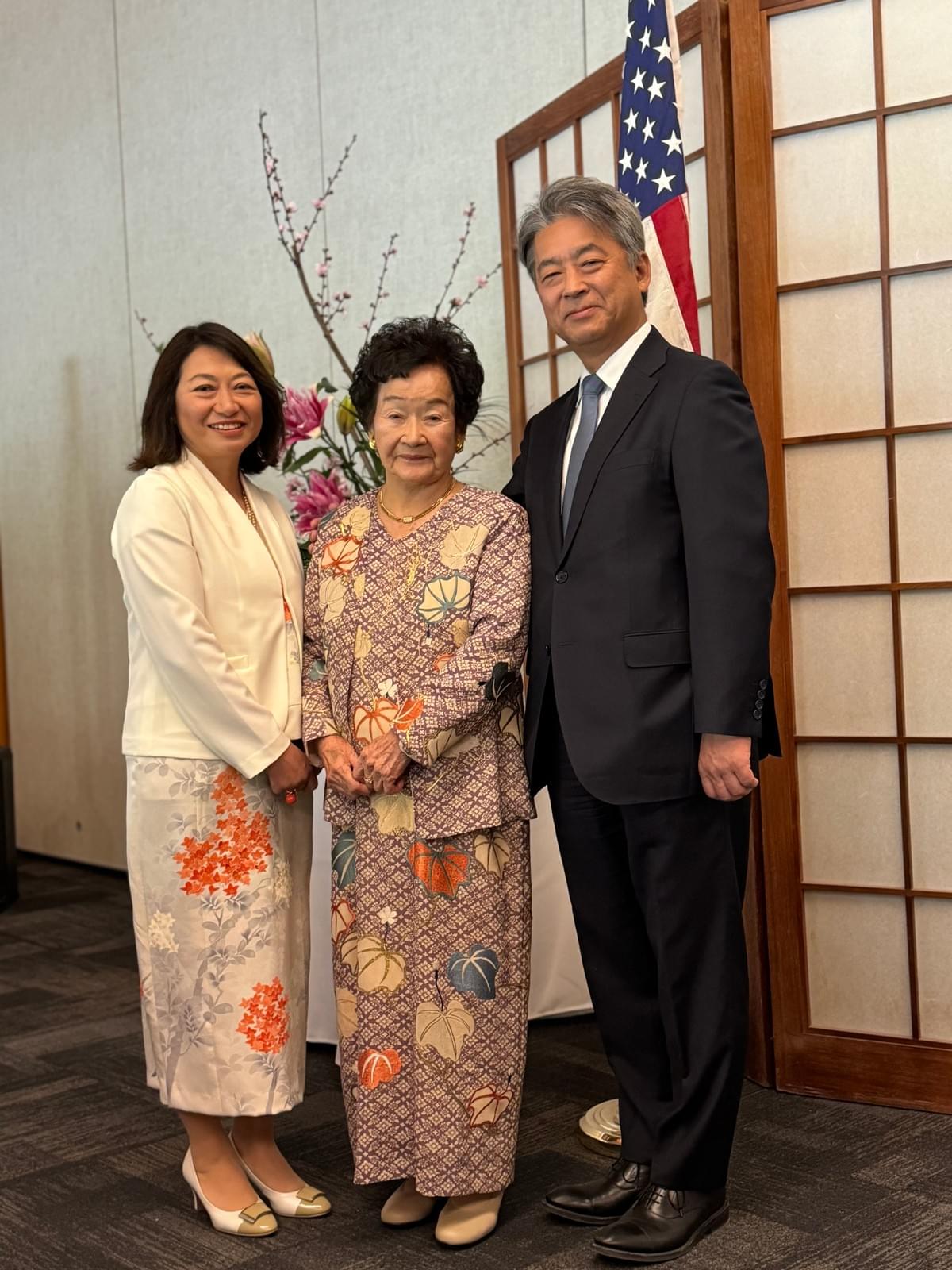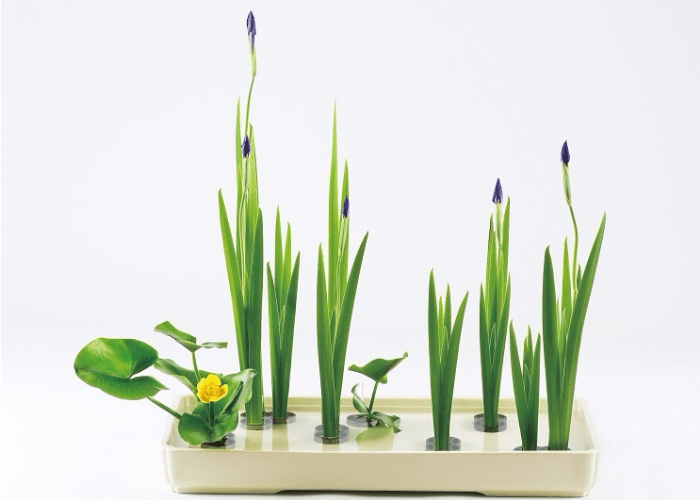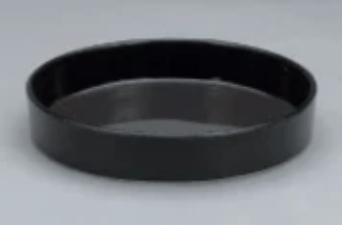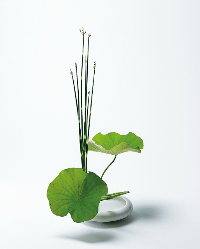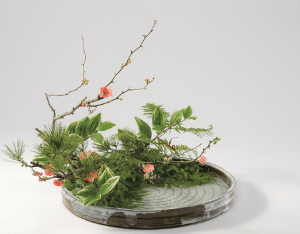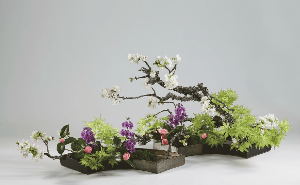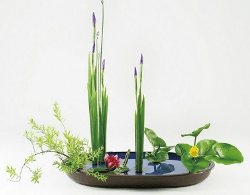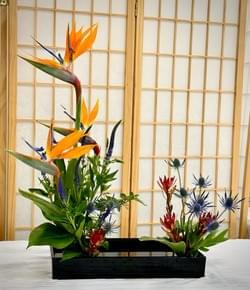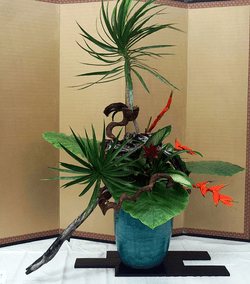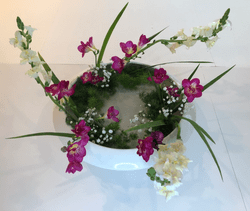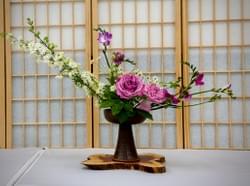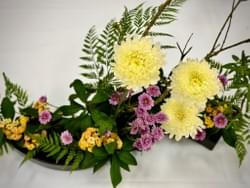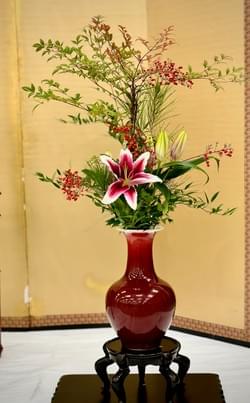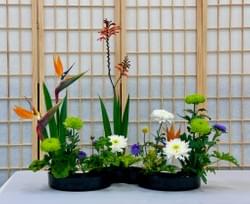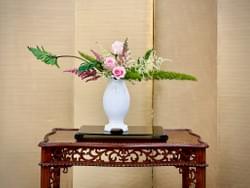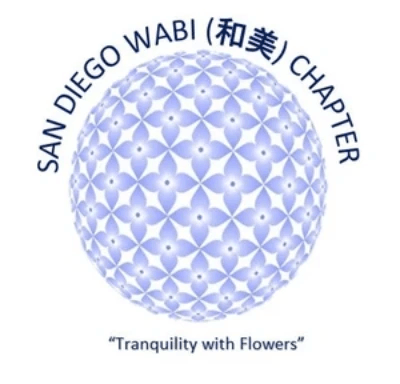
Hello & Welcome!
Welcome to the San Diego Wabi Chapter of the Ohara School of Ikebana. Devoted to the study of ikebana, as taught by the Ohara School of Ikebana, and to the principles of tranquility and friendship through flowers, the chapter welcomes everyone interested in the art of ikebana and the study of Japanese culture as expressed though ikebana.
The Chapter has more than 100 members who enjoy learning the art of ikebana as formulated by the Ohara School of Ikebana. We have an annual flower show, which is staged in Balboa Park and is free to the public, and teachers also stage workshops and demonstrations throughout San Diego County. Special events and classes are provided for chapter members.The blue hydrangea has been chosen to represent the desire of its members to promote harmony and friendship. The theme of the chapter is "tranquility with flowers." We welcome you to join us in this pursuit of harmony and friendship through the art of ikebana.

Special Awards for Akiko Bourland
2023 Foreign Minister’s Commendation and 2024 Orderof the Rising Sun

TheGovernment of Japan announced the recipients of its 2023 Foreign Minister’s Commendation from the jurisdiction of the Consulate General of Japan in LosAngeles, in recognition of her contribution to mutual understanding and friendship between Japan and the U.S. through promotion of Ikebana cultural art and other activities. Mrs. Akiko Bourland was given the scroll by Mami and Kenko Sone (photo at left), the Consul General of Japan, at the conferment ceremony on April 5, 2024 at the Inamori Pavilion, Japanese Friendship Garden of San Diego, in Balboa Park.
Mrs. Bourland was also awarded the extraordinary honor
of the Order of the Rising Sun by the Emperor of Japan in May. The Orderof the Rising Sun (旭日章, Kyokujitsu-shō) is a Japanese order, established in1875 by Emperor Meiji.The Order was the first national decoration awarded by the Japanese government, created on 10 April 1875 by decree of the Council of State. The design of the Rising Sun symbolizes energy as powerful as the rising sun in parallel with the "rising sun" concept of Japan ("Land of the Rising Sun").
TheOrder of the Rising Sun is awarded to people who have rendered distinguished service to the state in various fields, including the promotion of culture. Mrs. Bourland travelled to Japan to receive this award. More information is at:
https://www.la.us.emb-japan.go.jp/itpr_en/jokun_2024Spring_00001.htmlWhat is Ikebana?

Ikebana, one of the traditional arts of Japan, has been practised for more than six hundred years. It developed from the Buddhist ritual of offering flowers to the spirits of dead. By the middle of the fifteenth century, with the emergence of the first classical styles, ikebana achieved the status of an art form independent of its religious origins, though it continued to retain strong symbolic and philosophical overtones. The first teachers and students were priests and members of the nobility, but as time passed, many schools arose, styles changed, and ikebana came to be practiced at all levels of Japanese society.

The varying forms of ikebana share certain common features, regardless of the period or school. Any plant material - branches, leaves, grasses, moss and fruit, as well as flowers - may be used. Withered leaves, seedpods and buds are valued as highly as flowers in full bloom. While a work may be composed of only one, or of many different kinds of materials, the selection of each element demands an experienced eye, and the arrangement requires considerable technical skill in order to create a kind of beauty that cannot be found in nature.

What distinguishes ikebana from simpler decorative approaches is its asymmetrical form and the use of "empty" space as an essential feature of the composition. A sense of harmony among the materials, the container and the setting are also crucial. These are characteristics of the Japanese aesthetic feeling that ikebana shares with traditional paintings, gardens, architecture and design.
- Ikebana for Everybody, Ohara School of Ikebana
-Photos from https://www.ohararyu.or.jp/english
What is the San Diego Wabi Chapter of the Ohara School?
History
The San Diego Wabi Chapter of the Ohara School of Ikebana is an outgrowth of the Ohara Ikebana Society of San Diego, created in 2011 to include those who were interested in studying the art of ikebana as practiced by the Ohara School of Ikebana. Akiko Bourland, teacher and grandmaster of the Ohara School, was the first president of the society. The mission of the San Diego Wabi Chapter of the Ohara School of Ikebana is as follows:
- Promote, harmonize, and share the friendship and creative art of ikebana.
- Introduce Japanese flower arrangement techniques and culture as a community service through annual flower shows, demonstrations, and workshops presented by chapter members.
If you are interested in becoming a member of the Chapter, please contact us for the membership information. We look forward to seeing you at the chapter’s events.
Contact Us

Chapter Flower - Blue Hydrangea
The blue hydrangea, the flower of the San Diego Wabi Chapter, represents the chapter's desire to promote friendship, tranquility, and harmony among its members. The miniature blossoms of four that are interconnected by small strands and the spherical shape represent the members of the chapter working in unity and tranquility. The blue color is associated with calm and tranquility and symbolizes peace, friendship, devotion, understanding, and harmony among chapter members. The symbolic meaning of the blue hydrangea thus reinforces and represents the chapter’s theme of "tranquility with flowers" and is symbolic of the chapter’s name “Wabi.” (“Wa” is harmony, peace, and a spirit of unity and "bi" is beauty.)
The hydrangea was discovered in Japan, and its name is derived from the Greek words for water (hydor) and cask or jug (angos) and refers to the spherical shape of the open flower. Japanese legend relates that the emperor once sent a bouquet of hydrangeas to apologize to the family of a girl he loved--his only recorded apology. The flower has thus come to symbolize earnestness and communicates heartfelt emotions, and it is usually associated with friendship, devotion, perseverance, and understanding.
The hydrangea is also purported to have both medical and magical properties. Native Americans used the root as a diuretic and detoxifier and the bark was used to ease muscle sprains and burns, and it is still used in alternative medicine as a tonic herb. According to folklore, its magical properties come into play when a witch has placed a curse on a man or woman and the hydrangea is used to break the curse.

Founder
Grand Master Akiko Bourland was appointed Grand Master in 1996 after beginning study of ikebana in Yokohama, Japan in 1960. She moved to San Diego, California in 1970 and founded the San Diego Ohara Chapter in 1973, with an appointment as its president by Headmaster Houn Ohara.
Akiko has taught and demonstrated in many venues since her arrival to the United States. For her service to Ikebana International, she was selected by the board to be a life-time member.
In 1996 she gave a One-Woman exhibition at the Handlery Hotel, Mission Valley, San Diego. In 2000 Akiko published a book entitled, IKEBANA-Harmony through Flowers. The same year she was honored with commendations by the Governor of California, and earlier by the Mayor of San Diego and the President of the San Diego Community College. In 2001, Akiko received a special recognition from the Honorable Tuneo Nishida, Consul General of Japan, Los Angeles, for her contribution to promote mutual understanding and friendship between Japan and the United States.
Akiko has conducted workshops and given demonstrations to the North American Ohara Teachers Association Conferences in 2003 at Los Angeles, and in 2006 at Philadelphia, PA.

Certified Teachers
GRAND MASTER: Akiko Bourland
1ST MASTER: Mitsuko Takeya
1ST ASSOCIATE MASTER: Cris Bugarin, Peggy Cathcart, Michiko Kawamura, Mary Rawlings
2ND ASSOCIATE MASTER: Huimei (Vernna) Lai, Nakaba Emtesali, Vivian Fu, Pui Lan Ng, Marci Szeto
3RD MASTER: Winnie Davis, Joyce Hayashi, Rose Mary Johnston, Clara Leonida, Jenny Lo, Carole Scott, Vina Saycocie
4TH MASTER: Ken Fernandes, Junko Holmes, Ginger Truschke, Jessica Vargas-Miranda, Aya Zervas
INSTRUCTOR: Pennie Hatsue Brown, Donna Lohr, Lourdes Navor, Deborah Sharpe, Chieko Swinford, Tomoko Takashima
Elected Officers for 2024-2026
PRESIDENT Carole Scott
PAST PRESIDENT Huimei (Vernna) Lai
1st VICE PRESIDENT Cris Bugarin
2nd VICE PRESIDENT Clara Leonida
RECORDING SECRETARY Jill Fleming
CORRESPONDING SECRETARY Donna Lohr
TREASURER Ginger Truschke
What is the Ohara School of Ikebana?
Ohara School
Unshin Ohara founded the Ohara School in the late nineteenth century, when Japan opened itself to the influence of Western culture. He created the Moribana Style, which later led to the School's introduction of the Landscape Arrangement. Compared with the vertical or standing styles of ikebana of the past, in Moribana, flowers are "piled up" (moru) flat plate-like containers.

History of the Ohara School
In 2020, the Ohara School celebrated its 125th anniversary.
Unshin Ohara (1861-1916), the founder of the Ohara School of Ikebana, was born in Matsue City, Shimane Prefecture. Unshin explored the fields and mountains and tried to develop a style of ikebana to express the beauty of natural scenery. He also searched for ways to arrange the brightly colorful Western flowers that had just begun to be imported into Japan. The result of his efforts was Moribana, the first brilliant step in modern ikebana.
In 1897, the first public exhibition of ikebana in the Moribana Style was held. The Ohara School was officially founded in 1912, and in 1916, Unshin was succeeded by Second Headmaster Koun Ohara (1880-1938), who developed and established set techniques for Moribana.Koun held ikebana exhibitions in public places like department stores, and worked hard to promote Ohara ikebana to the great mass of ordinary people of that time. In addition, he paid considerable attention to developing practical teaching methods and to the systematic classification of expressive techniques.

More Recently in the Ohara School
Third Headmaster Houn Ohara (1908-1995) succeeded his father in 1938. As soon as the Second World War was over, he began his creative activity. Within the school itself, he made efforts to expand and systematize the organization. He also deserves great credit for transforming the school into a world-wide organization.
Houn's son Natsuki (1949-1992) became Headmaster Designate in 1972. Father and son held many joint exhibitions, and Natsuki embodied the future hopes and expectations of the Ohara School. He explored the possibilities of ikebana in search of richly creative forms appropriate for the new age, and originated Hanamai and Hana-isho. he was naturally expected to succeed his father, but he became ill and passed away while Houn was still Headmaster. Natsuki was posthumously named Fourth Master.
Now led by Fifth Master Hiroki Ohara, the Ohara School, which claims more than one million members, is expanding its activities not only in Japan but throughout the world.- Ikebana for Everybody, Ohara School of Ikebana
Teaching Schedule
Akiko Bourland
Grand Master
Advanced Study
By invitation only for instructor or above level
Email Address:
Second Wednesday of Month
Spring 2025
9:30 am - 1 pm
at Room 101 Casa del Prado, Balboa ParkMitsuko Takeya
1st Master
Spring 2025 classes start January 29
Email Address:
San Diego Community College Continuing Education
CRN 86041 Mondays 1-4PM (online)CRN 86038 Tuesdays 12:30-3:30PM
(hybrid)
Mission Valley Library
2123 Fenton Parkway
CRN 86043 Thursdays 9AM-12PM(hybrid)
Mesa College
7350 Armstrong Pl.
https://sdcce.edu/emeritus
Registration is open now
Huimei (Vernna) Lai
2nd Associate Master
Spring 2025 classes start January 29
Email Address:
https://ikebana-huimei-vernna-lai.mystrikingly.com/
San Diego Community College
Continuing Education
CRN 85928 Tuesdays 12-3PM
Mesa College
7350 Armstrong Pl.
CRN 85927 Wednesdays 9:30-12:30PM
Mira Mesa Sr. Ctr.
8460 Mira Mesa Blvd.
CRN 85931 Thursdays 9:30-12:30PM
CRN 85929 Thursdays 12:30-3:30PM
Miramar College
10440 Black Mountain Rd.
Registration is open now

Kenzan

Flat Bottom Container

Scissors
Styles of Ohara Ikebana

Hana-isho
Basic:
Rising Form
Inclining Form
Advanced:
Radial Fom
One-Row Form
Circular Form
Hana-isho is divided into two categories: Basic and Advanced. The first step is to master Basic Hana-isho, a simple type of ikebana that can be created and displayed anywhere.
Hana-isho has the following special characteristics:- It is a free kind of ikebana that even beginners can arrange easily.
- It is not merely for mastering ikebana techniques, but can be adapted to everyday life, since it is suitable even for small rooms or spaces.
- The compositions are simple and beautiful, and you can enjoy expressing the beauty of color combinations, form and the seasons.
- With Hana-isho, you are able to display fully your individuality, because you can arrange the principal and auxiliary stems freely according to the characteristics of the materials.

Moribana
Upright Style
Slanting Style
Water-Reflecting Style
Unshin Ohara founded the Ohara School in the middle years of the Meiji Period, when Japan opened itself to the influence of Western culture. He created the Moribana Style, which later led to the School's introduction of the Landscape Arrangement.
Until that time, almost all works of ikebana done in bowls or vases were arranged vertically in a "standing" form. This ancient vertical style was characterized by numerous limitations and so many strict, detailed rules that it was impossible to enjoy arranging flowers freely. However, by the time of the Meiji Period, large quantities of Western flowers had begun to be imported and cultivated in Japan. Life styles had also begun to change, so the ikebana that had developed from the past no longer suited the actual circumstances of everyday life.
At that time, Unshin Ohara originated a style of ikebana which incorporated the new Westeren flowers. His arrangements were suitable not only for the tokonoma alcove of traditional Japanese architecture, but for the new Western-style rooms of the period, such as drawing rooms and entrance halls. Furthermore, he originated a new style of ikebana that gave full play to the creativity of the arranger. The new style was called Moribana.
Moribana was subsequently adopted by most other ikebana schools and has now become the mainstream of the entire ikebana world. Thus, Moribana, originated by Unshin, became the forerunner of all modern ikebana. Compared with the vertical or standing styles of ikebana of the past, in Moribana, flowers are "piled up" (moru) in flat plate-like containers. Most works of Moribana use containers called suiban.
Hana-kanade
The word Hana-kanade is made of two kanji characters:
花 (hana) 奏 (kanade). The first character means flower; the second means to offer or dedicate. To be more precise, the character 奏 (kanade) is a compound ideograph formation, a kanji made up of meaningful parts. It is originally composed of three shapes: a shape of germinating plants, a shape of two hands offering something, and a shape suggestive of stepping forward.
This meaning of the character 奏 (kanade) can be associated with kuge, or
Buddhist floral offerings, one of the original purposes of ikebana. Kanaderu, the verb form of Kanade, generally means to play music with musical instruments, or gather voices and sounds to make music. Hana-kanade thus can be interpreted as ikebana compositions that students render by making the materials echo each other.
Hana-kanade is a three-dimensional arrangement that expresses the beauty of mutually crossing principal stems that move inwardly from their insertion points.The combination is made purposefully to express the beauty of the color, form, and season.
Hanamai
Hanamai expresses the beauty of plants brought out by their mutual interacting in three dimensional space.
There is no distinction between main material and auxiliary materials. Compared with the set floral styles of the Ohara School, Hanamai does not have fixed rules as to the length of stems. In fact, there are no rules governing the size, angle, or direction of materials. To capture the sculptural beauty of the materials, themselves leads naturally to the expression of three-dimensional beauty in Hanamai. Therefore, it is necessary to take a flexible approach and develop a good eye for the colors, forms, and textures of the materials. Different materials may approach, touch, overlap, mix, or interlace with each other to create beauty through contrast or through harmony. The basic standard is to use two materials, while three materials would be the limit.
Heika
Slanting Style
Upright Style
Cascading Style
Where as Moribana was originated and developed by the Ohara School, Heika, literally "vase flowers," is part of the ancient historical tradition of ikebana. Unlike Moribana, which is done in flat containers, Heika is created in tall, deep containers like vases and pots. The essential difference between the two is the way branches are arranged and fixed in position.

Rimpa Arrangement
This is the type of ikebana that is based on the designs of highly decorative paintings of the Rimpa school, which flourished during the Edo Peiord. The goal is to capture in ikebana the decorative qualities of floral materials and the overall design effects typical of Rimpa works of art. To this end, the unique characteristics of of plants are exaggerated or reduced. For the most part, materials used are those found in Rimpa paintings. Mastery of the Rimpa Arrangement depends upon knowledge and study of the original works of the Rimpa school artists.

Landscape Moribana
Traditional Method
Realistic Method
A form of ikebana which, while respecting the seasonal character and natural growth patterns of plants, uses an established range of materials and fixed methods of arrangement to exprress the beauty of a natural scene.
Membership Form
- Contact Us
The San Diego Wabi Chapter welcomes you at any time. Please contact us if you have any questions about our society events, classes, workshops or membership.
© 2021


